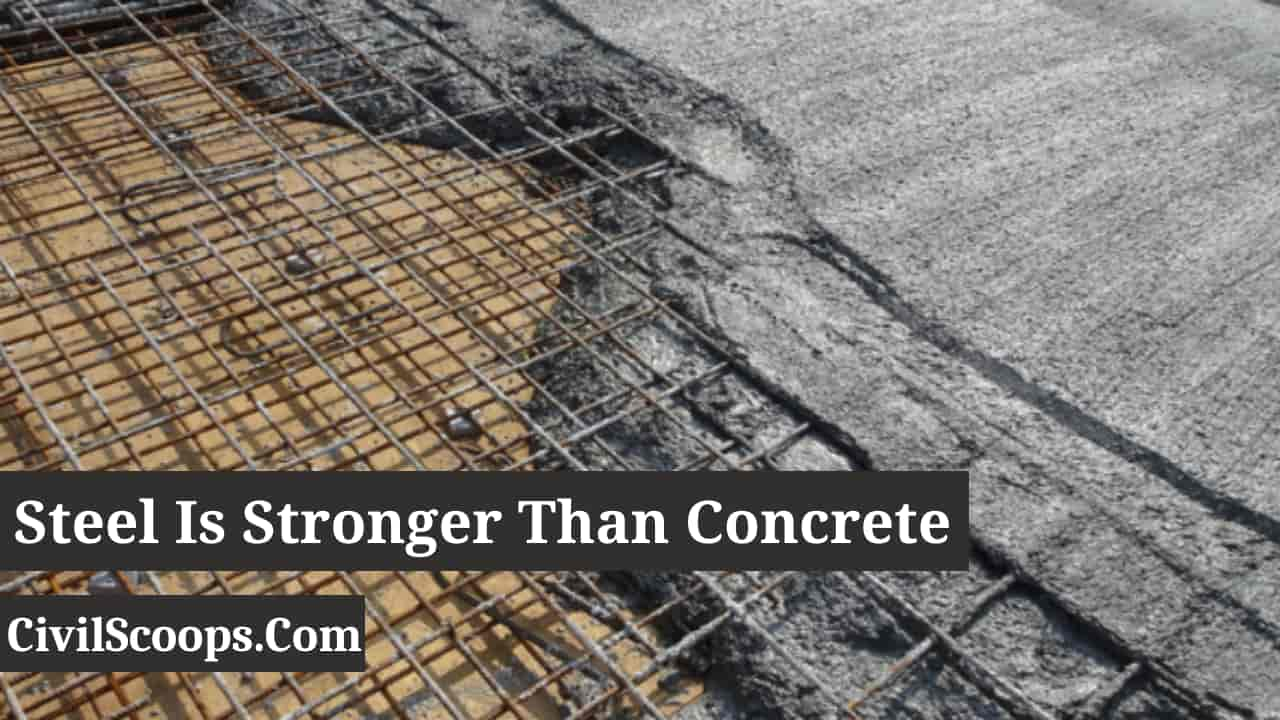Steel Is Stronger Than Concrete | Steel Vs Concrete
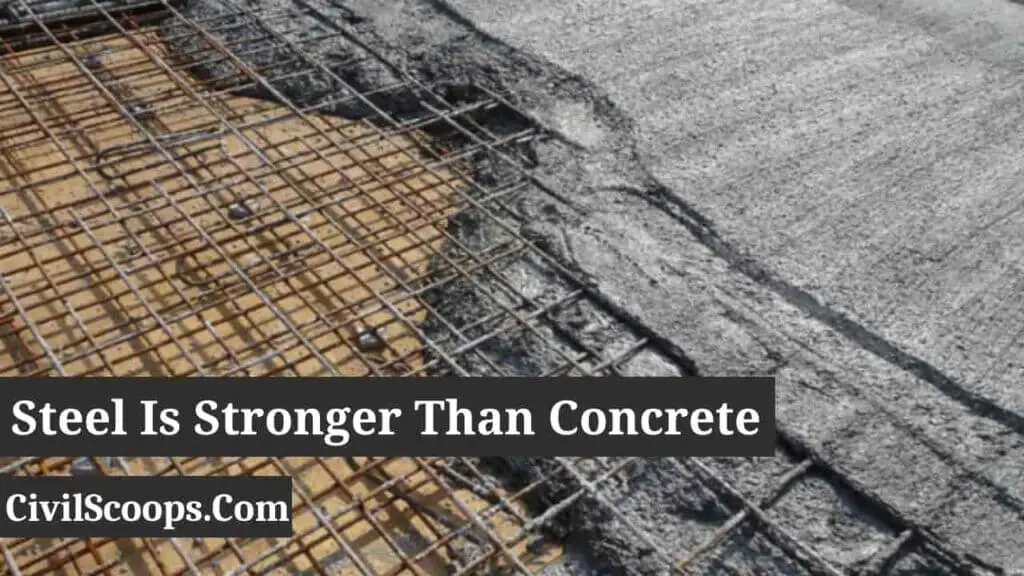
Table of Contents
Steel Is Stronger Than Concrete?
Because concrete has greater compressive strength than steel, steel bars are utilized in concrete to accommodate tension stresses due to the concrete’s weakness. The concrete wall alone is far more powerful than the steel mass.
Concrete buildings have significant safety advantages over steel structures. Concrete provides great explosion protection and can withstand extremely high temperatures for extended periods of time. Concrete structures are quick to construct and appealing.
Steel is also an option for big parts, but it takes more time and money to design, and the cost of insuring a steel structure is more than that of a concrete building due to variations in safety. Steel is increasingly widely utilized for environmental protection and reinforcement.
When it comes to building design, steel provides a wider range of alternatives. Steel has a higher weight strength than other construction materials.
Concrete is extraordinarily strong under compression, but it has no strength when tensioned; for this reason, rebar is utilised in concrete to provide it the capacity to withstand tensile stresses.
Reinforced concrete with steel is a better building material than concrete and steel alone. Concrete constructions can withstand compressive forces, but not tensile strains.
Difference Between of Steel and Concrete
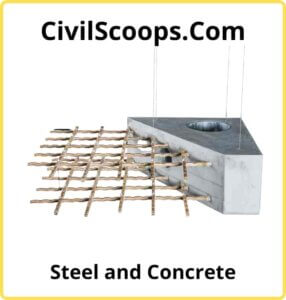
The steel used to make rolled steel structures, fastenings, and other parts for use in structural steelworks is referred to as structural steel. The Indian Standard Institution (I.S.I.) has standardized structural steel for use in construction, and specifications for various quality are given in the following standards (as per I.S 800-1984)
After water, concrete is the second most often utilized construction material on the planet. Concrete structures can withstand compression loads well, but they cannot withstand tensile loads.
As a result, when the structure is under strain, reinforcement is added to the concrete. Because of its durability and compatibility, concrete is widely employed in the building sector today. Furthermore, concrete can be molded into any shape, making it extremely versatile.
Concrete Construction Costs
The cost of concrete construction is influenced by a number of factors, including the concrete grade, the cost of supplies such as formwork, reinforcing steel, labour, and finishing. In addition to significant losses, these costs harm the contractor, the owner, or both.
Steel Vs Concrete

1. Steel Vs Concrete: Strength
Steel structure is a strong, rigid, ductile, and robust material that is widely utilised in industrial and commercial building construction.
Concrete is a substance made up of sand, water, gravel, and cement. Although the concrete has a higher compressive strength, it has a poor tensile strength. Concrete must be reinforced with steel to enhance the structure’s tensile capacity, elasticity, and ductility.
2. Steel Vs Concrete: Fire Resistance
Steel is a non-combustible material whose strength may be drastically reduced when subjected to high pressure. Steel must be coated with fire-resistant materials to increase safety.
Because of the nature of concrete, it is naturally fire-resistant. When concrete is utilized for building construction, many of the other components are not fire-resistant. Professionals should be familiar with all of the safety standards in order to avoid issues within the overall structure.
3. Steel Vs Concrete: Sustainability
Because 90% of steel structures are made from recycled steel, and steel constructions are 100% recyclable. Because of its lengthy lifespan, steel may be changed several times without compromising structural integrity. When constructed, the steel structure will have the least amount of environmental effect since it is carefully produced and handled.
Concrete is natural to our environment; it may be broken and utilized in various combinations, reducing the amount of concrete in landfills.
4. Steel Vs Concrete: Versatility
Steel is a versatile material for countless uses and may be produced in a wide range of designs. Steel gives several aesthetic possibilities which much higher materials and the strength to weight ratio than other materials
Concrete may be shaped into various forms and it has some restrictions when it comes to the floor to the floor and the log building heights.
5. Steel Vs Concrete: Corrosion
When in contact with water steel it may corrode, and if left without adequate maintenance, it may also damage structural safety and security. The treatment techniques are paint care and water resistance. Fireproof characteristics may be introduced when waterproof dyes are applied.
Reinforced concrete is waterproof and does not contain sufficient care and structure, and it is crucial that the steel reinforcement within is never exposed to exposure.
6. Steel Vs Concrete: Environmental Consideration
Using 90% of the steel recycled, steel is sorted with the magnets. The energy required for the manufacture of steel is increased at considerable distances.
Often locally produced concrete is necessary for shipment to areas with limited energy. Recyclicated steel rebar can be used for crushing and recycling of concrete and concrete at end of life, however recycled material for new constructions cannot be utilized.
How Strong Is Concrete?
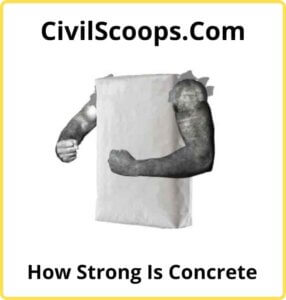
Strong enough concrete to carry a 3,000 psi compressive load in 28 days. Concrete can also be chosen for different forces. The strength of conventional concrete is 7000 psi or less; the strength of concrete is called high strength concrete between 7,000 and 14,500 psi.
Also Read: Difference Between Cement Plaster and Gypsum Plaster
Steel and Concrete Construction
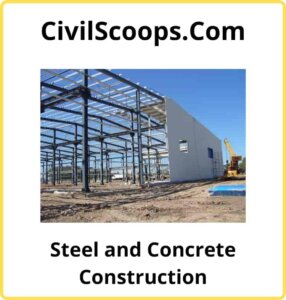
- Concrete is the second most often used building material, after water, since it is versatile, durable, and easy to fabricate, and it can be molded into any shape.
- Concrete constructions are extremely resistant to compression, yet they are unable to efficiently withstand tension.
- As a result, most concrete structures are reinforced with steel bars to offer extra tensile load support, and this combination is referred to as reinforced concrete.
- Concrete buildings may be constructed in a variety of ways and using various kinds of concrete. Plain cement concrete, reinforced concrete, and prestress concrete are the three most popular varieties.
- Plain cement concrete is made by blending cement, coarse aggregate (gravel), fine aggregate (sand), and water in the proportions specified by the designer. When these materials are hardened, they form a homogenous mass.
- Plain cement concrete structures have a high compressive strength but essentially little tensile strength.
- As a result, because these constructions are subject to compressive stresses, plain cement concrete is usually employed in roadways and concrete blocks for walls.
- Reinforced concrete is essentially normal cement concrete reinforced with steel bars that enhance tensile strength. This is the most popular form of concrete used in construction, with uses ranging from houses to structures such as water tanks.
- Prestressed concrete is preloaded before it is subjected to any load other than its own weight by adding compressive stress. Before applying external loads, high-strength steel tendons are tensioned within the concrete volume to induce compression. This increases its performance once it is put into service.
[su_box title=”FAQ” style=”default” box_color=”#333333″ title_color=”#FFFFFF” radius=”3″ class=”” id=””]
Steel
Steel, alloy of iron and carbon in which the carbon content ranges up to 2 percent (with a higher carbon content, the material is defined as cast iron). By far the most widely used material for building the world’s infrastructure and industries, it is used to fabricate everything from sewing needles to oil tankers.
Concrete
a mass formed by concretion or coalescence of separate particles of matter in one body. 2 : a hard strong building material made by mixing a cementing material (such as portland cement) and a mineral aggregate (such as sand and gravel) with sufficient water to cause the cement to set and bind the entire mass.
Tilt Wall Construction
Tilt-up construction features series of concrete panels tilted up into place to form a building’s exterior wall. These panels are created at the work site using wood forms, rebar and concrete. The forms are shaped and rebar cut to match final designs.
World of Concrete 2022
World of concrete 2022 will adhere to informa allsecure health and safety standards, as well as guidance from local authorities, and any venue or location-specific regulations.
Basement Foundation Repair
And just surface wipe the substrate. And then we’re gonna start off by applying esports. Next and one of these ports do for us we’re gonna introduce the low viscosity resin. Through these.
Nitronic 60
Nitronic 60 is a nitrogen strengthened austenitic stainless steel, with outstanding strength and resistance to wear and galling. It has corrosion resistance better than 304, and pitting resistance better than 316. It is also available in bar as a high strength version, nitronic 60 hs.
Concrete Foundation Repair
Dampen the crack by misting it with water from a spray bottle then push the hydraulic cement mixture into the crack with a putty knife. Let this dry for an hour or two then add another layer of cement mixture over the crack. Use a trowel to make the cement patch level and smooth with the wall surface.
Foundation Crack Repair
Step 1: repair a foundation crack with an epoxy sealer.
Step 2: block out the injection ports.
Step 3: mix the epoxy sealer.
Step 4: attach the injection port.
Step 5: spread sealer along the crack.
Step 6: inject the epoxy into the crack.
Step 7: seal up the injection ports.
Basement Crack Repair
Repairing the foundation of a house can cost as little as $350 for a single crack. However, the total cost can be tens of thousands of dollars if you’re also dealing with major structural problems.
Galvanized
Galvanization is the process of applying a protective zinc coating to steel or iron in order to prevent premature rust and corrosion. Proponents of galvanized steel, who may use it to construct or repair steel structures, for example, benefit from lower maintenance and repair costs because of its special properties.
[/su_box]
[su_note note_color=”#F2F2F2 ” text_color=”#333333″ radius=”3″ class=”” id=””]
Like this post? Share it with your friends!
Suggested Read –
- What Is Fresh Concrete? | Properties of Fresh Concrete | Factors Affecting Workability
- What Is Heat Resistance Concrete? | Reinforcement in Heat Resisting Concrete | Properties of Heat Resisting Concrete | Application of Heat Resisting Concrete | Advantages & Disadvantages of Heat Resisting Concrete
- What Is Traffic Rotaries? | Rotary Intersection | What Is Rotary Island? | Advantages & Disadvantages of Traffic Rotary
- What Is Development Length | Why We Provide Development Length | How to Calculate Development Length | Development Length for Single Bars
- What Is Tie Beam? | Tie Beam Details | Ties in Column | Tie Beam Design | Concrete Tie Beam | Tie Beam Reinforcement Details
- Types of Curing | Concrete Curing Time | How to Cure a New Concrete Slab | What Is Curing of Concrete | How Long Does Concrete Take to Dry | How Long Does It Take for Cement to Dry
[/su_note]
Originally posted 2024-04-05 05:13:59.

